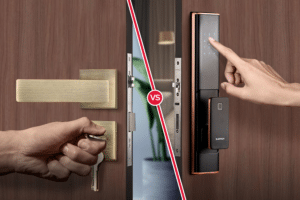With the summer heat peaking right now, everyone is looking for creative ways to stay cool without breaking the bank. There are many ways to reduce your energy usage, even when it feels like heat is radiating at you from all directions. Consider the smart thermostat.
Smart thermostats have seen a huge surge in popularity in recent years, but are they worth the cost of investment? Put simply—absolutely. Once you’ve experienced the life-altering convenience of adjusting the temperature from the palm of your hand—whether you’re home or not—actually walking over to your thermostat to change it will feel primitive by comparison.
Smart thermostats aren’t just an expensive convenience. About half of the average American electricity bill comes from heating and cooling alone, making climate control the single most significant contributor to your home’s overall energy usage. Many of these Wi-Fi connected thermostats learn your schedule, preferences, and even know when you’re home, helping you save on energy by automatically adjusting the temperature setting based on current need.
Even better, some of the different models on the market today remind you to change your air filter, help you diagnose problems with your A/C unit, encourage you to make more energy-efficient choices, and generally take the mystery out of controlling the temperature in your home. However, before you decide to order one, it’s important to understand the difference between the standard thermostat that came with your house (or apartment) and the new smart thermostat you’re considering.
What Is a Regular Thermostat?
Your standard thermostat is “that box on the wall” that controls the AC and heater. Other than occasionally turning a dial or pressing a few buttons, we rarely give it more than a few seconds of thought.
During the summer months, most of us lower the temperature inside the house to stay comfortable. The thermostat kicks in when the inside temperature begins to drop lower than the set temperature. When this happens, the thermostat tells the heater to kick on.
Once the room reaches the desired temperature, the thermostat again kicks in by now turning the heater off. This prevents the heat from continuously rising. The same process occurs with the air conditioner except the thermostat helps to cool the room when it senses that the temperature has exceeded the set temperature.
What Is a Smart Thermostat?
A regular thermostat allows you to adjust the temperature via a control panel on the wall somewhere in your home. A smart thermostat, on the other hand, allows you to control so much more.
Smart thermostats give you the opportunity to not only control your heating and cooling. They also allow you to do so remotely, while accounting for a variety of different factors, such as when you leave and come home from work, what areas of the house you spend your time in, and what temperature you like to keep the house depending on the time of day. Not only can you switch your AC on before heading home from work, you can now also program it to turn on and off based on your schedule, the current weather, and even when a certain number of people are in your home.
In addition to allowing for high levels of customization, smart thermostats also provide key details into your energy usage patterns, revealing just how much energy it takes to keep your home cozy in the winter and cool in the summer. Some of these devices even compare your AC and heater use to the average household for your neighborhood with helpful updates that show how much more energy you’re saving (or spending) and a gentle reminder to try to conserve energy.
But you don’t have to program an exhaustive, custom schedule for your AC to get the energy-saving benefits of a smart thermostat. In fact, you don’t have to program it at all. Since many of these Wi-Fi-enabled thermostats learn your habits and preferences over time, you can just let your new thermostat develop a schedule for you over the course of a couple of weeks. And if it’s too cold or hot, open the app and turn the air up or down to a more comfortable temperature to help it learn.
How Do Smart Thermostats Work?
The good news is that smart thermostats function just like regular thermostats. You can control the device via a smartphone app, but you can also use the touch-based interface on the device itself—just like on a traditional thermostat. Many people choose to adjust the temperature with the conventional controls as they become more accustomed with the app. This function also saves you from discomfort if you ever lose Wi-Fi (or misplace your phone) for an extended time, such as during a storm or scheduled maintenance in your area.
Can Smart Thermostats Save You Money?
Yes, they can—but how much and how quickly depends on your habits. With a smart thermostat, those who have long been meticulous about finding ways to conserve energy might not see much of a difference in energy savings after a year, especially compared to the average A/C user.
If you’ve made a dedicated effort to reprogram your thermostat every couple months, turn the controls off when you leave home, and generally try to keep the house warmer in the summer and colder in the winter, a smart thermostat will take longer to pay for itself. If you’re less meticulous, you’ll probably save enough to cover the cost of a new smart thermostat within the first year or two.[1]
How Much Can You Save With a Smart Thermostat?
There are a couple of ways a smart thermostat can help save money on your energy bill. First, programming your thermostat correctly can save you almost $200 a year alone. Analysis conducted by vivint on their customers’ data found that some smart thermostat users saved up to 23% on their heating and cooling costs. For some models, these kinds of savings can pay for the entire purchase price of a new smart thermostat in less than a year, with a little left over for LED bulbs or other energy-saving innovations.
Secondly, the “eco” or auto home/away feature included with many of these new devices helps you save money when you’re not home by automatically raising or lowering the temperature based on the ambient conditions outside.
And then there’s the convenience factor. Have you ever let the AC or heater run solely because it was too inconvenient to get up and adjust it? With your smart thermostat controls only as far away as your phone, you can change the thermostat temperature from wherever you are.
How Much Do Smart Thermostats Cost?
The model and brand of the new thermostat greatly influence the cost. Some smart thermostats come in around $100, while others exceed $500. It all depends on the model, brand, and level of sophistication.
In addition to the upfront cost of the smart thermostat, there might be associated installation costs and extra tools or materials required, so keep that in mind when you’re doing your research. Some of these smart devices come with simple, easy-to-understand instructions, and the necessary tools, for a quick home installation that you, or a tech-savvy friend, can handle. For those of us who aren’t confident in our ability to install a smart thermostat effectively and safely, professional installation can run up to $400, but the average cost is around $100-$250.
How to Save on Smart Thermostats
Some states and local city governments incentivize installing a smart thermostat with rebates, so be sure to run a search on rebates or other perks available in your area to help you save on a new device. Your energy provider also might offer exclusive discounts on smart thermostats, so check with them as well.
Does the Benefit Outweigh the Cost?
Technology gets more attainable every year, and smart thermostats are no exception. Every new iteration of this technology is more intuitive, user-friendly, and usually—more affordable. Everyone can benefit from greater control of their A/C, but until smart thermostats came on the market, not everyone was capable of taking advantage of the many opportunities to save energy.
Traditionally, barriers like inconvenience, complicated control schedules, non-standard operations, and just forgetting to adjust the temperature have kept most of us from making a significant dent in our energy bill. Smart thermostats level the playing field for the average user.
All in all, the benefits of smart thermostats outweigh the price tag. Not only do they provide an easy opportunity to make some cost-cutting habit changes, but they also give an in-depth, behind the scenes look into your actual energy usage like never before. Regardless of your reason for giving smart thermostats a chance, it’s a decision you won’t regret.
For those looking to learn more about smart thermostats, we can help. As one of the leading energy providers in North America, Just Energy isn’t just committed to providing top-flight energy service and customer support; we also advocate for the adoption of green energy initiatives and technology like smart thermostats.
Brought to you by Vivint East Dallas
Still Have Questions??
Give Vivint East Dallas a call today to schedule your free consultation and to hear how to pair with your home today.
Sources:
- A Guide to Energy-Efficient Heating and Cooling. (2009, August). Retrieved from https://www.energystar.gov/ia/partners/publications/pubdocs/HeatingCoolingGuide%20FINAL_9-4-09.pdf
- HomeAdvisor. (n.d.) How Much Do Thermostats Cost To Install & Replace At Home? Retrieved from https://www.homeadvisor.com/cost/heating-and-cooling/install-a-thermostat/





